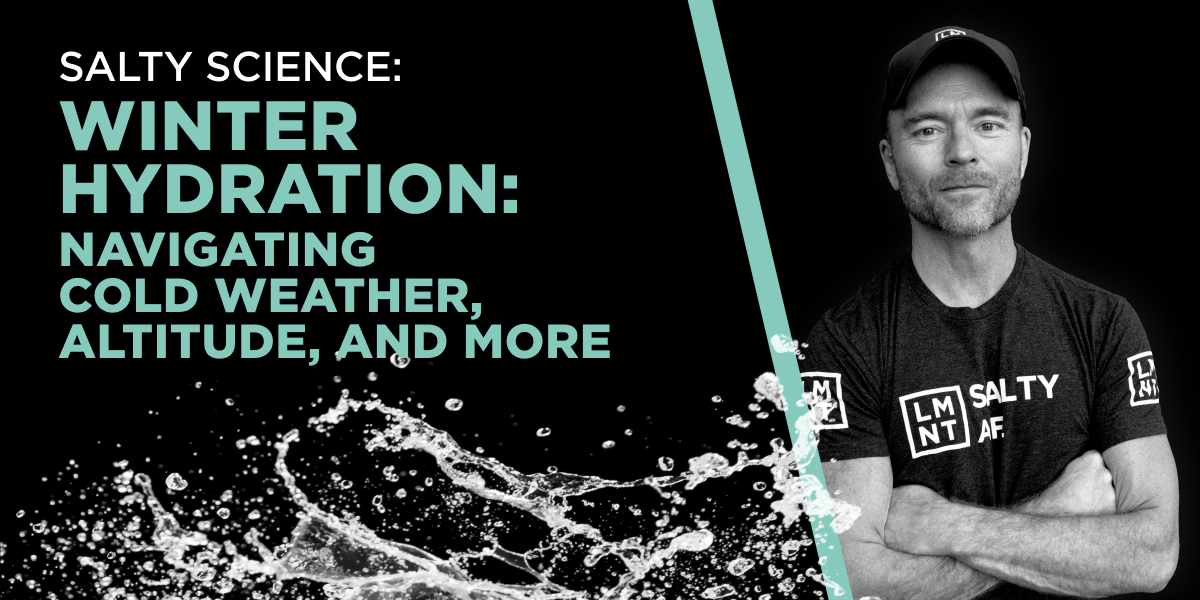Cold temps and high elevations present unique hydration challenges that most folks don’t consider.
In the cold, your thirst mechanism doesn’t work as well, you lose more fluids through diuresis (i.e., you pee more), heavy winter clothing can cause you to sweat more, and you lose more moisture through your breath due to the dry air.
Hydration at altitude is especially tricky. Seasoned mountain climbers typically require more water in their first week at elevation to prevent dehydration. But after that, they sometimes restrict water and sodium intake to prevent the serious complications that can come with Acute Mountain Sickness.
The point is that winter hydration—even for those of us somewhat less altitudinally ambitious—requires a little more thought than hydrating through the summer months. But the takeaway is still the same: to find balance with a Goldilocks amount of fluids and electrolytes that lets your blood flow nicely in your veins, your brain float serenely in your skull, and your organs stay the right size. You’ll feel the difference when you get it right.
So all you skiers, snowboarders, sledders, ice skaters, alpinists, cold weather runners, snowmobilers, and driveway shovelers—this one’s for you. Let’s talk about how to stay hydrated throughout the winter.
Hydrating in Cold Weather
A widespread but false belief is that cold weather reduces our hydration needs. Set that belief aside, and you’ve overcome the first obstacle to healthy winter hydration. Now we’ll explore the physiological challenges of hydrating in cold weather.
#1: Cold-induced diuresis
In 1764, a man named Alex Sutherland noticed that he peed more after a cold bath. Centuries later, scientists now speculate this “cold-induced diuresis” is driven by higher blood pressure after cold exposure. As blood pressure rises, the kidneys excrete more fluids and electrolytes to reduce blood volume and decrease blood pressure.
Cold-induced diuresis isn’t easy to quantify, but we know the following trends:
- More intense cold exposure increases diuresis
- Dehydration reduces diuresis
- Moderate exercise reduces diuresis vs. being sedentary
- An upright posture reduces diuresis vs. lying down
All that to say, you probably pee more than usual in the cold, unless you’re 1) already dehydrated, 2) performing moderate exercise, or 3) both.
#2: Increased metabolic rate
In the cold, two main mechanisms increase your metabolic rate:
- You’re working harder than you usually would (i.e., tramping through the snow)
- You’re wearing cumbersome winter clothing that can raise energy needs by 10–20%
As your metabolic rate rises, your sweat rate rises along with it. You must replace those fluids and electrolytes to stay hydrated.
#3: Respiratory water losses
You also lose more water through your breath when it’s chilly. Here’s why.
When thinking about relative humidity, it’s wise to pay special attention to the word “relative.” Quite cold temperatures—even at 100% relative humidity—can contain significantly less water vapor than hot temperatures at, say, 50% relative humidity.
The point is: cold outside air is almost always drier than warm outside air. When you breathe in that cold, dry air, your respiratory system acts like a humidifier — fixing the air to match your body’s preference: warm and humid. Unfortunately, as soon as you exhale, you push all of that wonderful moisture back out into the world.
For example, in one study, respiratory water losses after a full day of activity nearly doubled at -4°F compared to 77°F. The answer is not to stop breathing — it’s to keep hydrating!
#4: Sweating in winter clothes
Layers of heavy clothes might be perfect for lounging outside the ski lodge, but that gear gets sweaty QUICKLY on the slopes. Then you wonder why you keep getting the whole ski lift chair to yourself.
In one study, researchers evaluated people at -4°F wearing a U.S. Army Extended-Cold-Weather Clothing System, which has the warmth of about 4 business suits. The subjects barely sweat at all while resting, but they lost nearly 2 liters of sweat per hour while exercising.
That’s a high sweat rate, but here’s the kicker: Reducing the warmth factor of the Army clothing by half reduced sweat rates by a factor of 5! The point is, you should gear up wisely to stay reasonably warm and minimize perspiration. If your equipment gets soaked and you stop moving, the temperature of your gear could drop or even freeze, which lead to hypothermia.
#5: Lack of drinking water
If you’re camping in the winter, don’t rely on melted snow for drinking water. According to an old study on winter survival, “it would take more than six hours per day and a half a gallon of gasoline to get sufficient water for one man.”
You’re much better off hauling your water, but be mindful of it turning to ice. If you bring a non-insulated bottle, you may find an icicle in your backpack.
#6: Reduced thirst
During survival experiments in arctic temperatures (no thanks!), participants only reported thirst once they came inside and warmed up. They were dehydrated from the cold, but their bodies didn’t tell them.
More recent experiments have quantified this effect. In a 2004 study, men exercising in shorts and t-shirts experienced 40% less thirst at 39°F compared to 80.6°F, regardless of hydration status. The authors believe the mechanism involves blood vessel constriction in the cold, which may trick the body into thinking blood volume is higher than it is.
#7: Overhydration
Until now, I’ve talked mainly about the dangers of under-hydrating in the cold. Many forces—diuresis, heavy clothes, broken thirst—work against us. But this doesn’t mean that more water is always better. An overly-aggressive fluid replacement strategy can dilute blood sodium levels, leading to a dangerous condition called hyponatremia.
This brings us to the Iditasport Ultramarathon, a 100-mile run through the snowy wilderness of Alaska that makes a standard marathon look like a walk around the block Only the bravest endurance athletes take on the Iditasport.
Unfortunately, many don’t get their hydration right. In one study on 16 Iditasport runners, 7 were hyponatremic following the race. The researchers found that these runners consumed more water and less sodium throughout the race than the others.
Hydrating at High Altitude
Now let’s talk about hydration challenges at high elevations, many of which overlap with those at cold temperatures.
#1: High-altitude diuresis
Like the cold, high altitudes can cause our kidneys to excrete more fluids and sodium. This “hypoxic diuretic response” results from inhaling 25–50% less oxygen (hence: hypoxic) than usual. Hypoxic diuresis tends to kick in within hours of exposure to a low-oxygen environment, and often subsides within 1 week of acclimation. For that week, remember: The higher you climb, the thinner the air, the more you pee.
#2: Acute mountain sickness
Acute Mountain Sickness is a condition of excessive fluid accumulation that affects about 25% of low- or mid-elevation folks like myself who travel to a place above 8,200 feet. And there’s nothing cute about it: Symptoms include headaches, GI issues, fatigue, dizziness, and sleep disturbances. The causes are unclear, but researchers believe increased blood vessel dilation, blood-brain barrier issues, and capillary leakage are involved.
Research indicates that Acute Mountain Sickness presents around 1 week at elevation, after the hypoxic diuretic response has died down. Consequently, a reasonable high-elevation hydration strategy might entail sodium and fluid replacement during the first week to counteract diuresis, and then fluid and sodium restriction if Acute Mountain Sickness symptoms present later.
Still, this protocol depends on the individual. Some cases may resolve by moderating (or restricting) fluids and sodium, while others may require a diuretic to keep swelling down. Some people don’t get Acute Mountain Sickness at all. My advice? If you’re concerned about an upcoming trip to the mountains, seek the advice of a trusted medical professional.
#3: Your thirst mechanism at high altitude
We all tend to experience reduced thirst at elevations around 14,000 feet, the approximate height of Pikes Peak in Colorado. This phenomenon can result in 2–3 liter fluid deficits during the first few days at altitude. Fortunately after then, the thirst mechanism adapts to elevation and returns to normal.
#4: Increased sweating at high altitude
When you train at high elevations, you take in less oxygen. Less oxygen means harder work, which elevates your metabolic rate and increases how much you sweat.
Interestingly, since low-oxygen stress increases exercise intensity, many athletes intentionally train in hypoxic environments to improve their aerobic fitness. In one study, athletes trained in a hypoxic chamber 3 times per week for 6 weeks. The training simulated an altitude of about 10,000 feet, and it improved participants’ VO2 max better than training at sea level (VO2 max measures your maximal oxygen uptake, an indicator of aerobic fitness). The authors summarize that “Exercise in hypoxic conditions acts as a stressor to yield greater physiological and metabolic functions than an exercise in normoxic conditions.” This is an interesting counter point to the “train low, live high” axiom which has informed endurance training for better than 50 years, so cool stuff!
Your Winter Hydration Strategy
Don’t be fooled by the frigid temps—winter hydration matters too. Let’s recap the unique hydration challenges posed by cold and elevation.
In cold temperatures, you:
- Sweat more due to higher metabolic demands (from bulky clothing or higher work rates)
- Lose more fluids and electrolytes through urine
- Lose more water through respiration
- Don’t get as thirsty
- Need to haul your water in an insulated bottle to prevent it from freezing
And at high altitudes, you ALSO:
- Sweat more due to higher metabolic demands (from less oxygen intake)
- Lose more fluids and electrolytes through urine
- Don’t get as thirsty (this issue wears off in a few days)
- Should be mindful of Acute Mountain Sickness—and possibly restrict fluid and electrolyte intake to prevent swelling after 1 week of altitude exposure
Generally, I suggest drinking electrolyte water throughout your winter activities, sipping slightly beyond what thirst dictates. The exception is Acute Mountain Sickness, where folks should probably restrict fluid intake.
Electrolyte water should contain enough sodium (about 1 gram per 20–30 ounces) to mimic healthy blood sodium levels and prevent hyponatremia. Mix a saline solution by adding half a teaspoon of salt to your water bottle, or use an all-in-one electrolyte drink mix like LMNT.
Whatever solution—pun intended—you choose, minding your winter hydration will help you stay jolly throughout the season.

